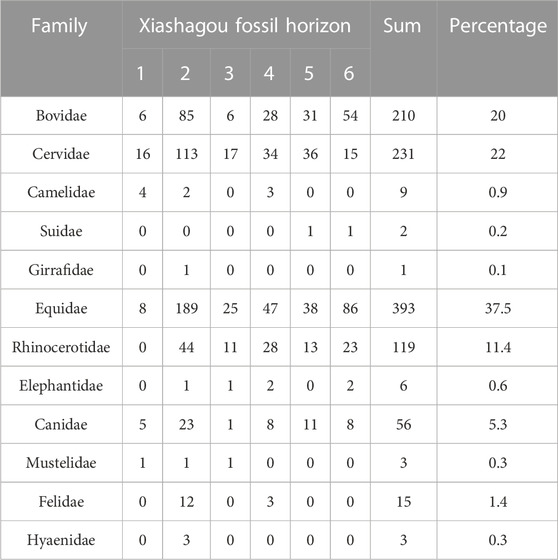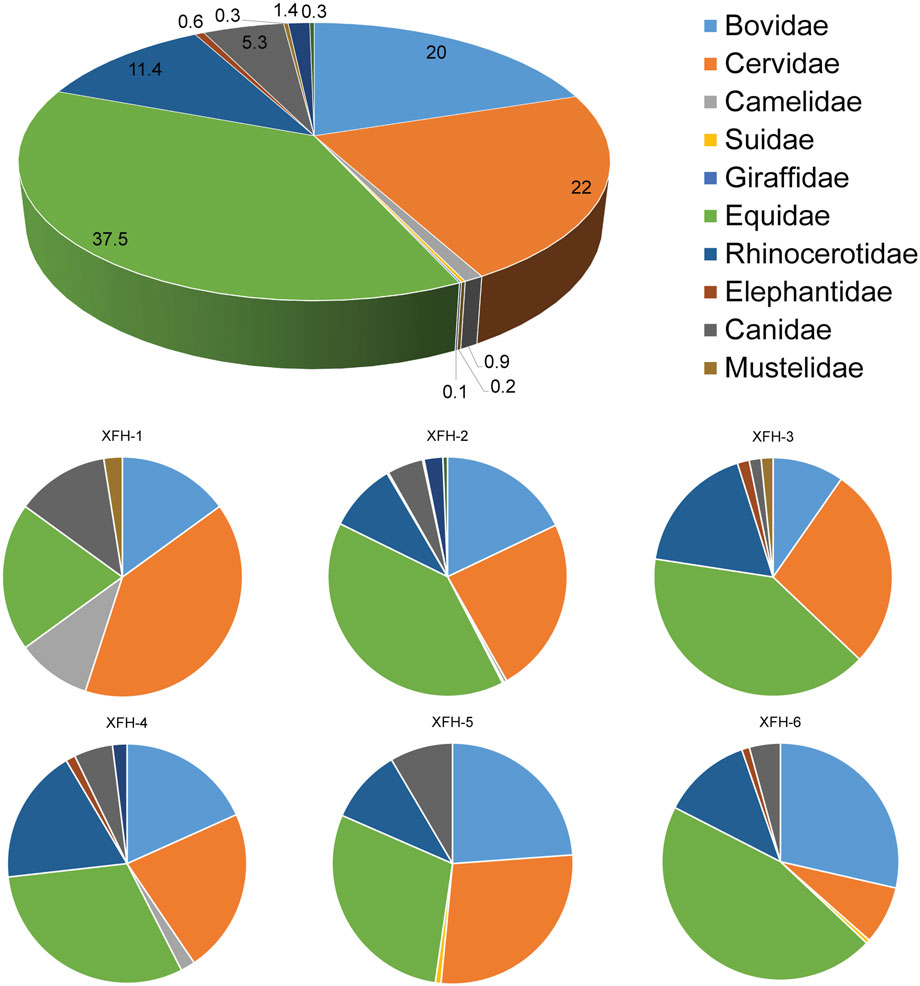- 1Centre for Vertebrate Evolutionary Biology, School of Life Sciences, Yunnan University, Kunming, China
- 2Key Laboratory of Vertebrate Evolution and Human Origins of Chinese Academy of Sciences, Institute of Vertebrate Paleontology and Palaeoanthropology, Chinese Academy of Sciences, Beijing, China
- 3College of Earth and Planetary Sciences, University of Chinese Academy of Sciences, Beijing, China
- 4Scott Polar Research Institute, University of Cambridge, Cambridge, United Kingdom
- 5Department of Biology, Indiana University of Pennsylvania, Indiana, PA, United States
The Nihewan Basin is infilled by a relatively complete Pliocene to Pleistocene sequence, rich mammalian fossils and containing many Palaeolithic artefacts, implying that it is a unique location for Quaternary multidisciplinary study. Fossil excavations in these deposits have been carried out for nearly a century. The systematic study of the fossils by Teilhard de Chardin and Piveteau in 1930 laid the foundations for the classic Nihewan Faunal assemblage, which has been widely followed as a standard for the Early Pleistocene biochronology in eastern Asia. With the availability of magnetostratigraphic analyses on several sections in the Nihewan basin, a comprehensive geochronological study is timely pending. Here we report the results of a comprehensive survey of the Xiashagou section, where the classic Nihewan Fauna was discovered. By synthesising the lithostratigraphical, biostratigraphical, and magnetostratigraphical information, together with measurements taken by the authors, the total thickness of the Nihewan Formation in the Xiashagou section being 116 m. Furthermore, the geochronological study demonstrates that the classic Nihewan Fauna was originally recovered from at least 6 fossil horizons, spanning from ∼2.4 Ma to ∼1.8 Ma, i.e., the early Early Pleistocene. The new evidence from the Xiashagou section also suggests several cycles of fluctuations in the biodiversity and population of the classic Nihewan Fauna during the early Pleistocene. The preliminary correlation of these cycles matches the short periods of glaciation in the early Pleistocene.
1 Introduction
The initial scientific explorations of the deposits on the outskirts of Nihewan village, located on the east bank of the Hulihu River in Hebei province (Figure 1) began in 1924–25 (Barbour, 1924; Barbour, 1925; Barbour et al., 1926). These works divided the Nihewan strata into four groups: (a) Zone of the “Red Clays,” (b) Zone of gravels and sand, (c) Middle zone of sand and clays, (d) Zone of white marls. They also reported finds of fragmentary remains of Rhinoceros, Bos, Elephas, and a cervid. Subsequently, E. Licent (1936) undertook an extensive excavation in the Nihewan basin, which lead to the discovery of almost 2,000 fossil specimens, while citing some of these excavations in his diary. Emile Licent emphasised the similar age of all the fossil mammals he excavated in the Xiashagou valley. Meanwhile, Teilhard de Chardin identified 42 species among 31 genera from the Nihewan Bed together with Piveteau and suggested that the Nihewan Fauna belongs to the roughly same horizon (25 pockets) and was comparable with the European Villafranchian faunas (Teilhard de Chardin and Piveteau, 1930) or more precisely above the Quaternary/Neogene boundary that defined by the Vrica marine section on the top of C2n (=Olduvai), dated 1.796 Ma (Qiu Z., 2000). These early discoveries eventually led to the recognition of the Nihewan Basin as a standard lower Pleistocene stratum of East Asia at the 18th International Geological Congress in 1948. Henceforward, the “Nihewan Bed” became the standard stratum in North China for this period, continuously utilized for correlation with other Neogene faunas (Huang 1974; Wei, 1976; Cheng et al., 1978).
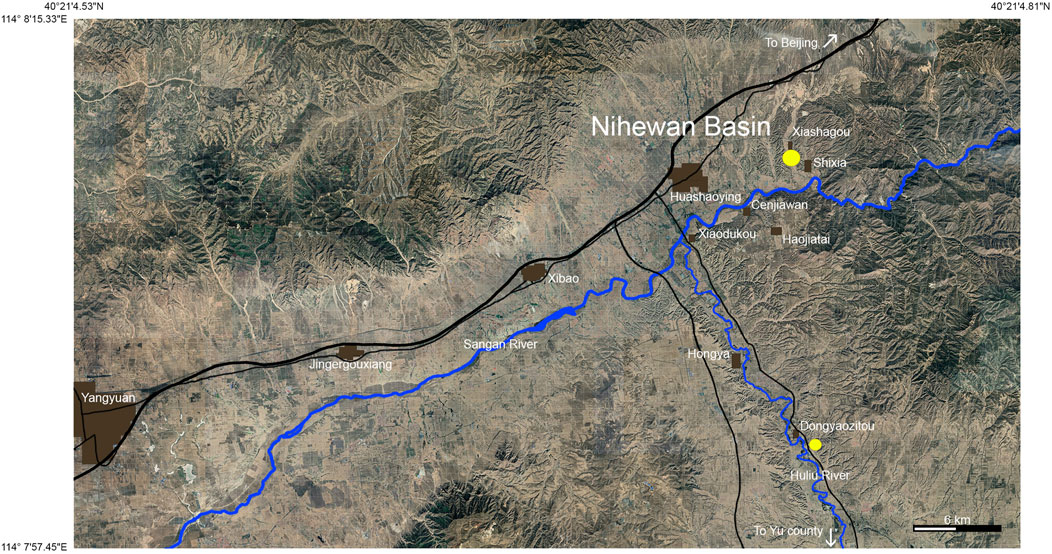
FIGURE 1. The location of Nihewan Basin in Hebei, China, and the important villages in the area. The two fossil localities that produced the Nihewan Fauna and Dongyaozitou Fauna are marked with big and small yellow circles.
The excavations in the Nihewan Basin deposits and the succession fossil sites also surprisingly resulted in the discovery of numerous sites and artifacts (Wei, 1974; Chia et al., 1979; You et al., 1979; Jia and Wei, 1980; Cai, 1987; Wei, 1994; Wei et al., 2003; Deng and Zheng, 2005; Cai et al., 2008; Ao et al., 2010; Hou et al., 2010; Keates, 2010; Liu et al., 2010; Pei et al., 2010; Jia, 2011; Tong, 2012; Dennell, 2013; Liu et al., 2013; Tong et al., 2014; Liu et al., 2016; Ao et al., 2017; Tong et al., 2017a; Tong et al., 2017b; Chen and Tong, 2017; Guo et al., 2017; Pei et al., 2017; Yang et al., 2017; Rui et al., 2019). The importance of the presence of early hominids in the Nihewan Basin, as well as the abundant fossil, has greatly motivated a series of studies to investigate the geological, geochronological setting (Cheng et al., 1978; Huang, 1980; Wu et al., 1980; Chen et al., 1986; Yue and Jiang, 1986; Du et al., 1995; Yang, 2001; Li et al., 2008; Liu et al., 2013; Chen et al., 2015) and palaeoenvironment of the Nihewan Basin based on palynological analyses (Liu, 1980; Zhou and Liang, 1983; Li et al., 2016; Ding et al., 2020), Electron Spin Resonance (ESR) (Jin et al., 1987; Yang et al., 1993; Wang et al., 1997; Xia and Han, 1998; Liu et al., 2010; Duval, 2015), Optical Spectrometry Luminescence (OSL) (Nagamoto et al., 2009; Zhao et al., 2010), fossil invertebrates (Huang and Guo, 1985; Liu, 1989), geochemical properties (Yue and Wen, 1990), stromatolites (Li and Yuan, 1992; Xia et al., 1993), and palaeomagnetostratigraphy (Yang and Li, 1999a; 1999b; Su et al., 2000; Løvie et al., 2001; Qiu et al., 2001; Wang et al., 2003; Hong and Deng, 2004; Wang et al., 2005; Min, 2006; Zhu et al., 2007; Deng et al., 2008; Ao, 2010; Zuo et al., 2011; Ao et al., 2012; Liu et al., 2012; Ao et al., 2013; Liu et al., 2014; Liu et al., 2018). The summary of these studies showed that the Nihewan strata spans part of the Pliocene, the Lower Pleistocene, and part of the Middle Pleistocene, but does not extend into Upper Pleistocene (Long et al., 1991). The results have demonstrated that the sequence preserves evidence for numerous cycles of climatic change (Xia, 2001; Zhang et al., 2020; Farjand et al., 2023), the impact of which led to the appearance and later disappearance of ancient Lake Nihewan together with its contained classic Nihewan Fauna (Liu and Xia, 1983; Xia, 1992; Yuan, et al., 2009).
Currently, over twenty new fossil sites, and four formations have been recognised within the deposits filling the Nihewan Basin. These formations are: 1. The early Pliocene Shixia Formation, 2. The late Pliocene Daodi Formation, 3. The Pleistocene Nihewan Formation, and 4. The overlying Malan Loess (Du et al., 1988; Yang et al., 2003; Wang et al., 2013). Based on the current biostratigraphical setting, two major large-mammal assemblages, the Nihewan and Dongyaozitou faunas (the latter also known as the Danangou Fauna) are recognisable. This contrasts with three distinct phases of mammalian evolution that were previously identified during the Pleistocene in the region (Cai et al., 2004).
The Dongyaozitou Fauna, based on the presence of Lynx variabilis sp. Nov., Zygolophodon sp., Coelodonta antiquitatis, Hipparion sp., Paracamelus sp., Antilospira yuxianensis sp. Nov., Gazella sinensis, Axis sp. (Tang, 1980), and small mammals including Orientalomys nihowanicus, Ochotona lagrelii, and Ochotona minor (Zheng, 1981; Qiu, 1985; Zheng and Li, 1986; Cai, 1989; Zheng and Cai, 1991; Zhang et al., 2003) represent a distinctly different assemblage from that of the Nihewan Fauna, the latter representing a slightly older phase. Based on the presence of Hipparion sp. In the Danangou section Tang et al. (1981), suggest that a lower Quaternary is more plausible for this assemblage. Therefore, the Danangou section can be subdivided into two parts. The upper part yields the classic Nihewan Fauna, whilst the lower part comprises the Dongiaozitou Fauna. This assemblage is comparable to the Youhe Fauna of Weinan, Shansi (Shaanxi), or Etouaires of early Villafranchian (Teilhard de Chardin and Piveteau, 1930) age in Europe (Tang and Ji, 1983; Li, 1984).
Despite all the previous studies, lack of a reliable chronological record for the Nihewan strata, combined with the lithological complexity, has delayed construction of a biostratigraphical record for the classic Nihewan Fauna. The presence of late Pliocene species [e.g., Hipparion (Proboscidipparion) sinense] together with extant species (e.g., Ovis ammon) in the Xiashagou section strengthen these uncertainties that classic Nihewan Fauna may represent a longer time interval than was previously thought. In this study, the classic Nihewan Fauna housed in the Tianjin Natural History Museum (TNHM) was analysed and combined with numerous fieldwork and the recently relocated original fossil localities (Farjand et al., 2023) to present the first biostratigraphical profile of the classic Nihewan Fauna.
2 Materials and methods
2.1 The classic Nihewan Fauna
This research’s primary materials were the original classic Nihewan Fauna excavated in the early 20th century by Émile Licent around Xiashagou village (Figure 2). At present, most of these specimens (roughly 1,600 specimens) are housed at the Hoang Ho Pai Ho Museum, the predecessor of the TNHM and IVPP (28 specimens) although some of the best-prepared specimens (126 specimens) were relocated to MNHN, France. This dispersion is one of the many obstacles to studying the classic Nihewan Fauna since some species are only housed in specific institutes (e.g., the Suidae material is only housed in the MNHN).
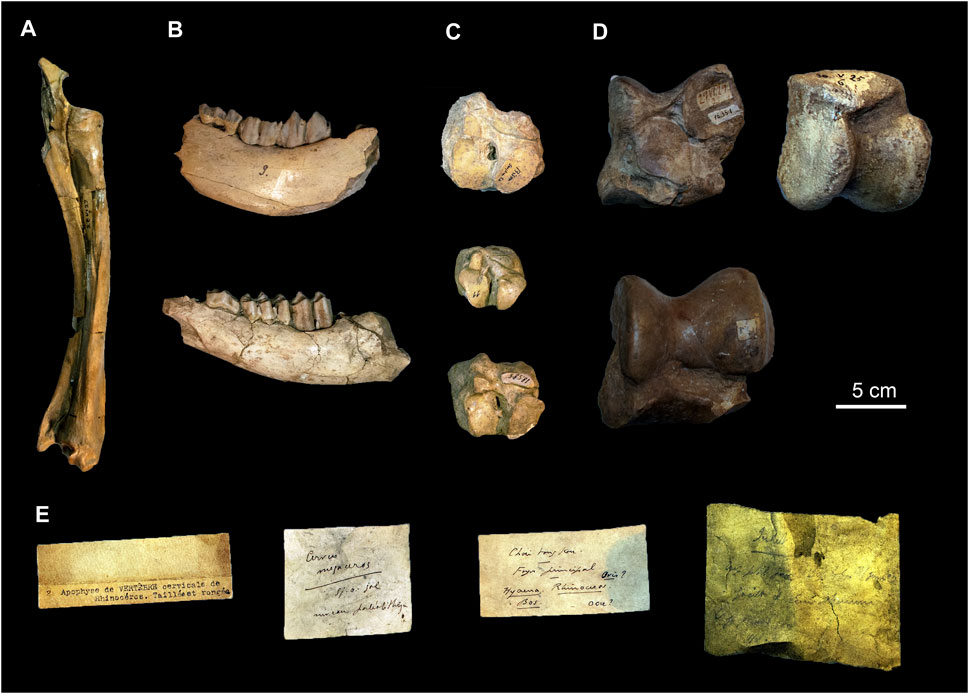
FIGURE 2. Some of the specimens used in this study, Tianjin Natural History Museum (TNHM). (A). A left radius and ulna of a Cervidae, (B). Broken mandible of a Cervidae, (C). Three separate Bovidaes’ carpals, (D). Four separate Rhinocerotidaes’ astragali. (E). The original identification and explanatory notes that cooperate with some of the specimens.
The classic Nihewan Fauna primarily consists of large mammals, including four orders of Perissodactyla, Artiodactyla, Carnivora, Proboscidea, and many genera. Therefore, the specimens were catalogued, noting the characteristics and information of all known species of the classic Nihewan Fauna in a database and thus succeeded in updating the list of classic Nihewan Fauna (Table1).
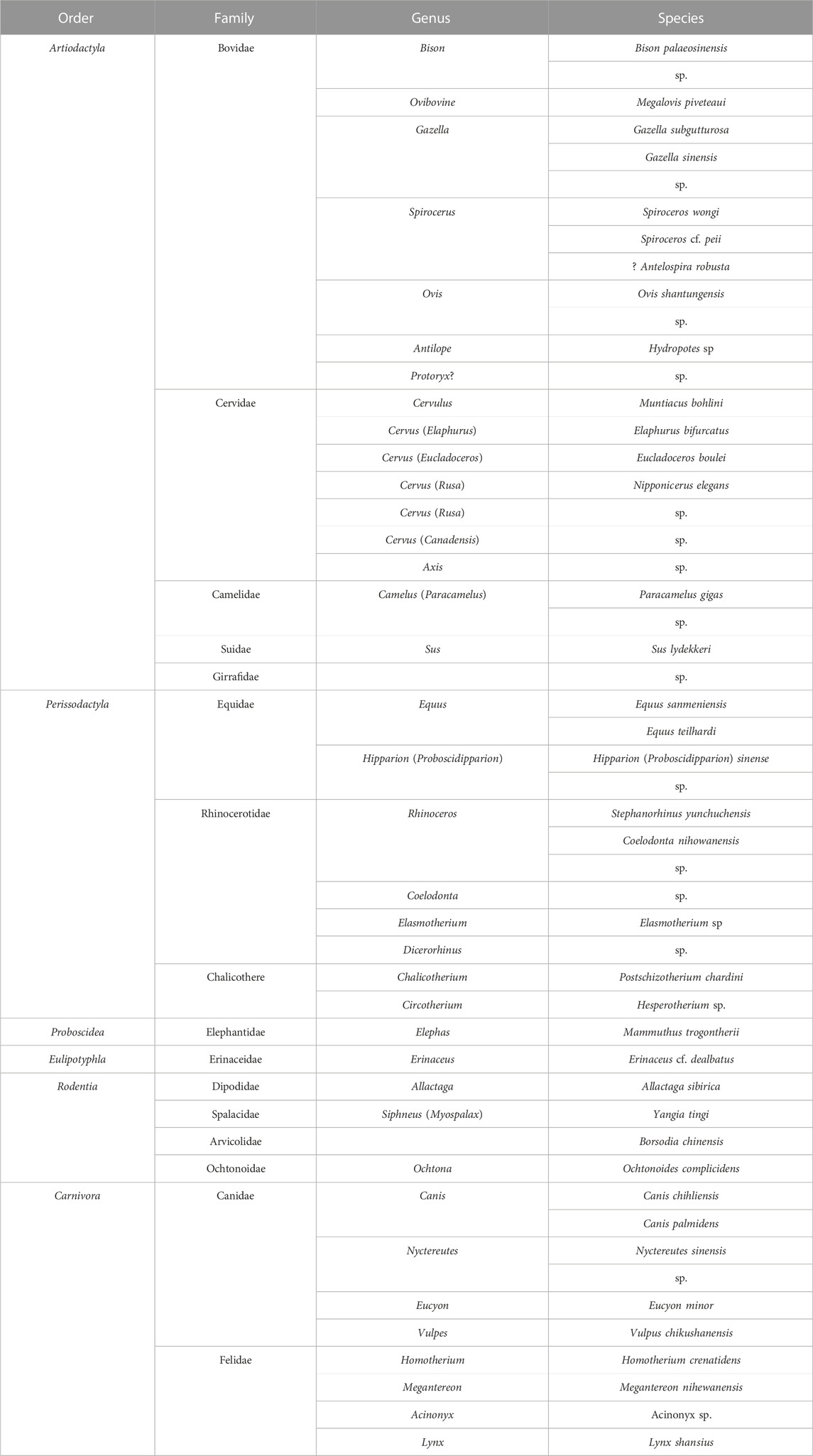
TABLE 1. The updated list of classic Nihewan Fauna. Modified after Tong et al. (2021).
Measurement of the specimens was executed by using a digital calliper and, in some instances, a laser measurer for measuring the larger specimens. These statistics, accompanied by identification tags, and other important properties of each specimen, were then recorded in a broad sheet Excel file. Additionally, since the authors were not granted permission to relocate some of these specimens, the selected specimens were photographed.
2.2 Biostratigraphy
The term Nihewan Basin in this study is mainly adopted to refer to sections within three main gorges incised into the basin infill in the vicinity of the village of Nihewan. These gorges are named from east to west Shixia, Xiashagou and Langdonggou. Yet, a continuous outcrop of Nihewan Formation is exposed in none of these places. Therefore, all these localities were surveyed, the sequence systematically measured, and the fossil and sediment were sampled. For the sedimentological analysis in the field and logging, the method of Stow (2010) was followed, while the biostratigraphical profile was compiled by following Lister (1992) and Wang et al. (2013).
As a standard technique, the following stages were followed in constructing the Nihewan Formation and Fauna biostratigraphical profile: 1. Locate the area of interest and identify the exposed rock formations; 2. Find potential mammalian fossil sites within the formations; 3. Conduct stratigraphical analyses in the area to determine the approximate age of the rock formations; 4. Measure the thickness and distribution of the rock formations at five locations, and identify the different strata within the Nihewan Formation; 5. Collect mammalian fossils from each layer or stratum, and identify each fossil’s species and approximate age; 6. Compare the collection of mammalian fossils with those from other areas and stratigraphic sequences to build a chronological framework for the area of interest; 7. Determine the age of the rock formations within the area by matching the mammalian fossils to known time periods in the geological timescale; 8. Use the established chronology to correlate the rock formations within the area to other geological sequences and to interpret the region’s geological history. Overall, the original classic Nihewan Fauna was analysed to determine their relative age and this information was used to build a chronological framework and interpret the geological history of the Nihewan Formation.
3 Results
In the previous study of the original fossil localities of the classic Nihewan Fauna, Farjand et al. (2023), rediscovered 30 of the original fossil sites (Table 2). This study used the position of these fossil localities to find their position on the overall stratigraphy of the Nihewan Formation. As a result, it was shown that the classic Nihewan Fauna occurs at least six fossil horizons (Table 3, Table 4). Furthermore, the number and diagnosis of each specimen and their appearance on these fossil horizons were noted. These data show a shift in the biodiversity of classic Nihewan Fauna during the Early Pleistocene that coincides with the lithological and perhaps paleoclimate alterations.
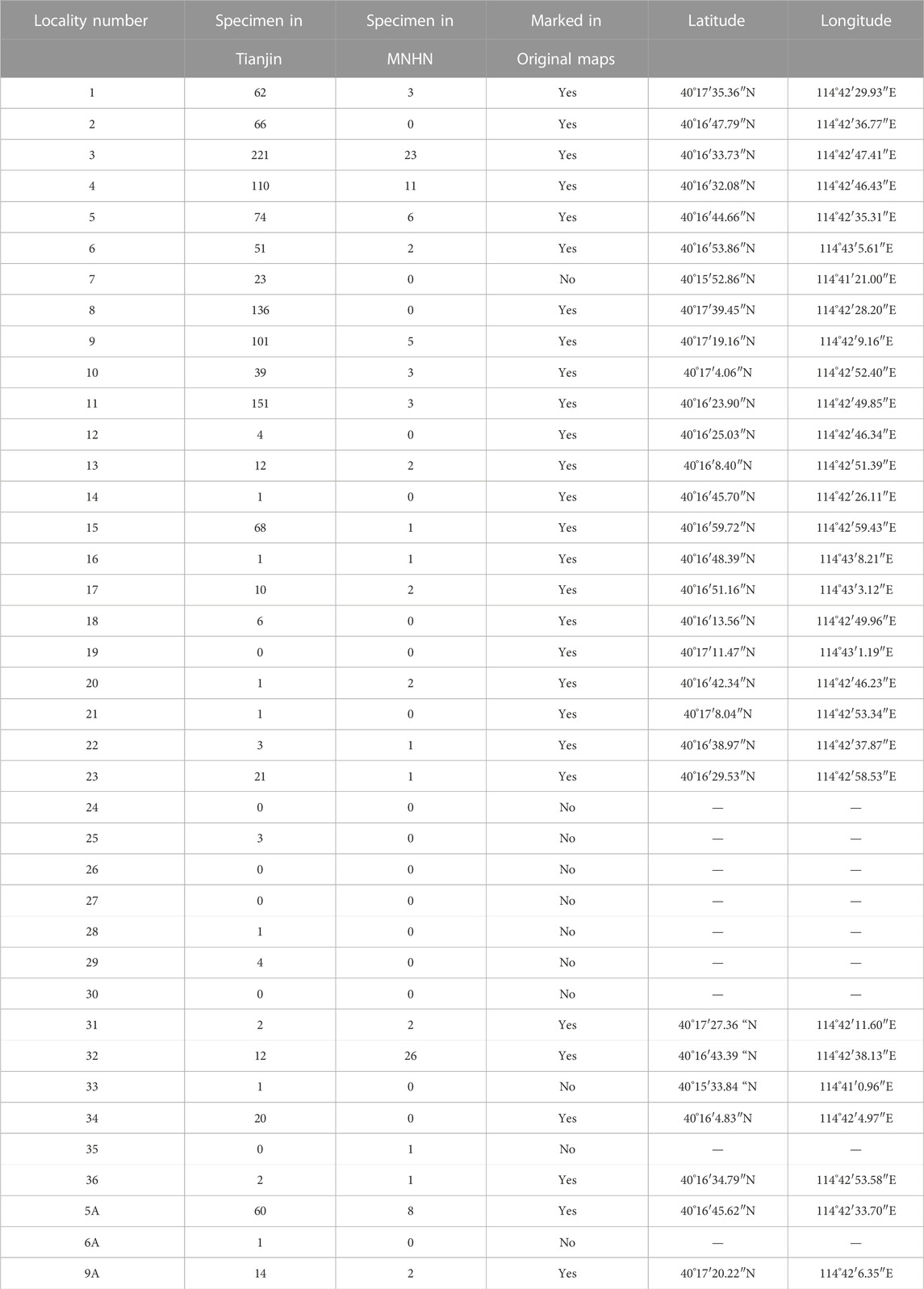
TABLE 2. The location of original fossil localities of the Classic Nihewan Fauna in the Xiashagou Valley (Farjand et al., 2023).
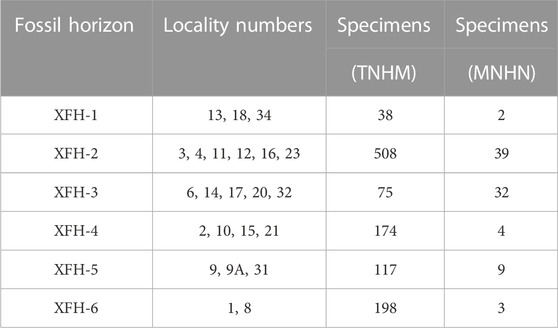
TABLE 3. Identified Fossil Horizons in the Nihewan Formation, Xiashagou section (Farjand et al., 2023).
The actual thickness of the Nihewan Formation was measured in the Xiashagou section at 116 m. Here the sequence could be divided into three members based on lithological changes (Figure 3). Each of these members represents different phases of the depositional process and numerous minor lithological changes during the Plio-Pleistocene. The lower member of the Nihewan Formation is only exposed to the south of the Xiashagou villages on the eastern side of the valley. This member is comprises massive reddish/brownish sandy, silty claystone (Figure 4). Unlike the red clay of the Shixia Formation, there is no visible calcareous or carbonate concentration. This thick red silty clay/clayish silt overlain at least 3.5 m of gravel and conglomerate. This coarse fluvial deposit marks the onset of deposition of the Nihewan Formation in the Xiashagou section. Moreover, this member’s thickness was measured 14.5 m.
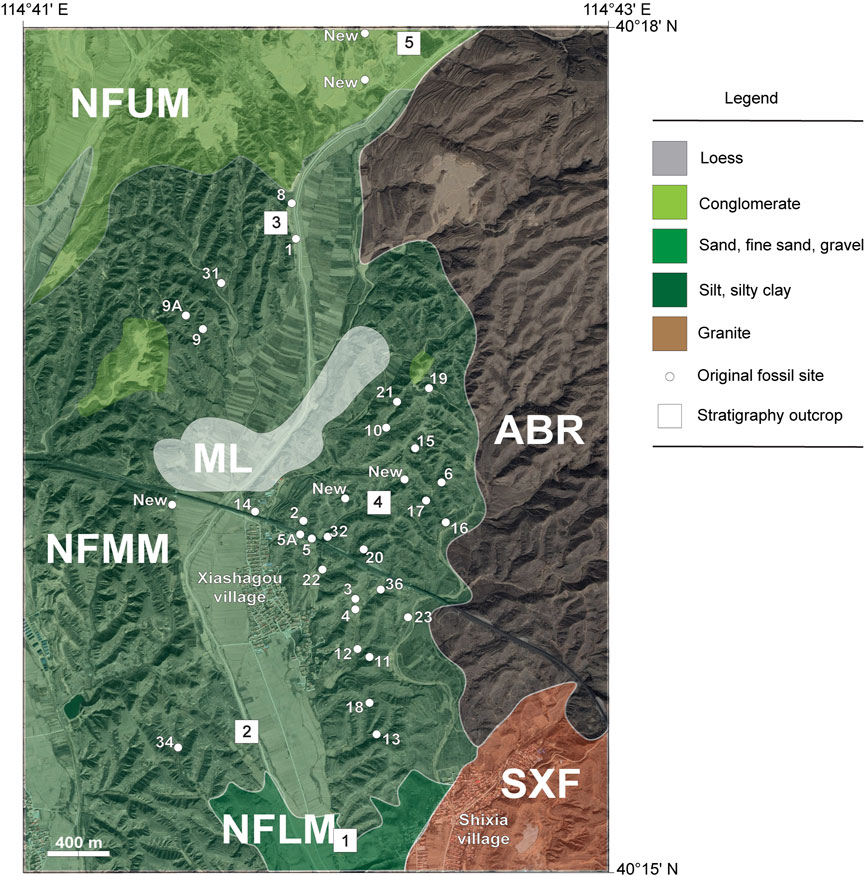
FIGURE 3. Rediscovered original fossil localities around the Xiashagou village and the geological setting. The numbers 1 to 5 mark the location of outcrops that were measured for reconstructing the biostratigraphical profile.
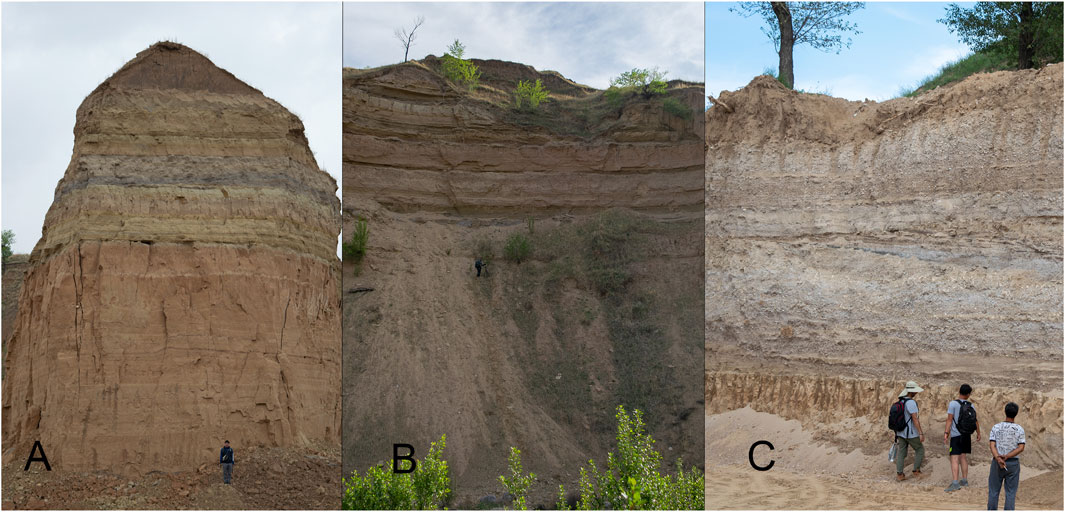
FIGURE 4. (A) The Lower member, (B) The Middle member, (C) The Upper member of the Nihewan Formation in the Xiashagou section.
No original fossils nor localities were identified from the lower member, except some newly discovered Equidae fragments and some ichnofossils. The magnetostratigraphical data from Liu et al. (2012) shows that the Gauss–Matuyama magnetic boundary is located within this unit. The age of these deposits is therefore estimated at 2.6 to 2.4 Ma (i.e., basal Pleistocene). We emphasize that the current authors have carried out no original magneto-stratigraphic work.
The middle member of the Nihewan Formation displays a rapid change in lithology and the palaeoenvironment. This member comprises fluvial sediments dominated by current-bedded yellow sand and silty sand interbeds with thin layers of pebbles and gravel lenses (Figure 4). These strata are about 44 m thick. This unit retains all the original fossil sites. The current magnetostratigraphy suggests an age of 2.4 Ma at the base and its termination by the end of the Olduvai Subchron at 1.8 Ma.
The appearance of thick fluvial cycles of cross-bedded gravel and sand characterises the Nihewan Formation’s upper member (Figure 4). The upper member outcrops in various places north of Xiashagou village, where Malan Loess abruptly overlies this member. We measured around 55 m of the upper member.
This member includes none of the rediscovered original fossil localities. However, the authors did recover small mammal remains from the lower, and a broken antler and mandible from the middle part of this member. Chronologically the onset of the Upper Member coincides with the termination of the Olduvai Subchron (i.e., 1.8 Ma), and it continues to the beginning of Brunhes normal polarity reversal, while containing the Jaramillo Subchron. Therefore, the paleomagnetic data suggest an age of 1.8 to 0.6 Ma.
4 Discussion
4.1 The Early Pleistocene climate change
The Early Pleistocene is widely known for the multiple, yet short glacial/interglacial climatic periodicity with c. 40 ky cycles (e.g., Lisiecki and Raymo, 2007), which later gave way to the 100 ky cycles during the Mid-Pleistocene transition. (Huybers, 2006). These fluctuations in temperature and precipitation eventually drove the mass migrations and megafaunal extinction by the end of the epoch. For example, by the middle of the Early Pleistocene, many large Felidae, Hyaenidae and even small Canidae, such as Nyctereutes sinensis (Farjand et al., 2020), had disappeared from the Nihewan Basin. Indeed, the Nihewan Faunal assemblages exceptionally portray this transformation.
The Early Pleistocene deposition in the Nihewan Basin (lower member) exhibits a low-energy palaeoenvironment predominantly represented by lacustrine sediments. This massive brownish silty clay and silt are contemporaneous with deposition of the Wucheng Loess (An, 2014) and the retreating Nihewan Palaeolake. Later, climatic change and uplift of the Nihewan strata determined the form and character of the Nihewan Formation Middle and Upper members. In comparison, the Middle member records numerous cycles of water flow, alternating dry and wet periods, whilst the Upper member is marked by forming of proximal alluvial fan deposits and a feeder river. This alteration was observed during the fieldwork and was previously mentioned by authors (Farjand, et al., 2023). Hence, it is safe to interpret the paleoclimate change during the Early Pleistocene as impacting both the biodiversity and population of classic Nihewan Fauna. The intense change towards the colder periods of the Middle Pleistocene may have caused the final disappearance of the Classic Nihewan fauna elements or push them to beyond the basin. Pollen evidence for the environmental context of the Early Pleistocene in the Xiashagou section also indicates three cycles of cold and two warm intervals (Zhang et al., 2020).
The chronology of the classic Nihewan Fauna suggests a younger age than that of the Dongyaozitou and Danangou Fauna (Farjand, et al., 2023). However, the presence of several elements of the classic Nihewan Fauna in the older and younger strata necessitates further studies. The new discovery of large and small mammals in the Nihewan Formation upper member and hipparion material in the lower member is a testimony to the possibility that the classic Nihewan Fauna may represent a longer time span as well as including the Dongyaozitou Fauna as well. For this reason, and in the light of the evidence presented above, the Xiashagou section is proposed here as the type of section for the Nihewan Formation.
4.2 Biostratigraphy and geochronology of the classic Nihewan Fauna
The discovery of the original excavation sites and the subsequent fossil beds helped the authors to identify six fossil horizons in the Middle member of the Nihewan Formation (Farjand, et al., 2023). These fossil horizons contain several original excavation sites and have a unique age. Despite the similar lithological properties in which these fossil horizons occur, they vary in fossil abundance and large-mammal distribution (Figure 5). Chronologically, the lowest fossil horizon occurs at c.15 m above the Gauss–Matuyama magnetic boundary. Therefore, this lowest horizon represents an age of ∼2.4 Ma. By contrast, the topmost fossil horizon is dated to the termination of the Olduvai Subchron. Therefore classic Nihewan Fauna represents an interval of 2.4 to1.8 Ma. Within this time span we recognized 6 fossil horizons.
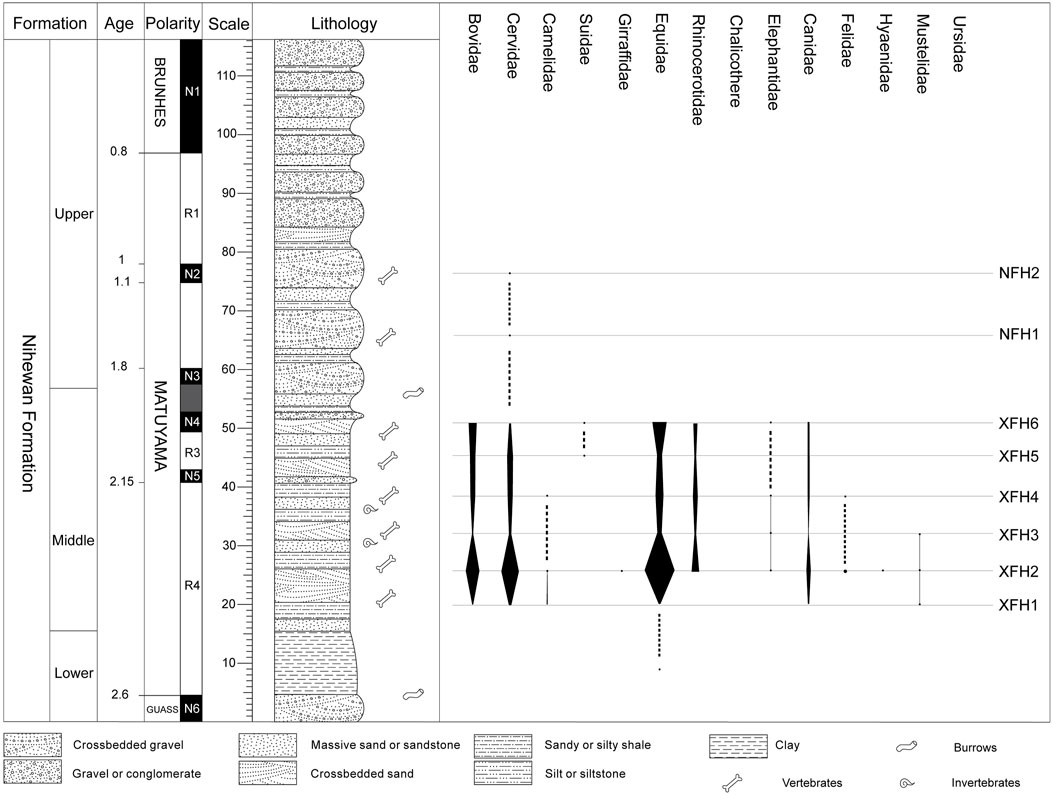
FIGURE 5. The biostratigraphical profile of the classic Nihewan Fauna and the sediment log of the Nihewan Formation. The magnetostratigraphical profile is modified from Liu et al. (2012).
The Xiashagou Fossil Horizon 1 includes localities 13, 18, and 34. In total, 40 specimens of Bovidae sp., Cervus sp., the first appearance of Eucladoceros boulei, Paracamelus sp., Equus sanmeniensis, Canis sp., and Meles had been identified from this horizon. The Xiashagou Horizon 2 occurs at localities 3, 4, 11, 12, and 16, the richest localities, yielding 474 fossil specimens from this fossil horizon. This horizon also has produced most of the classic Nihewan Fauna (32 species). Hence, it represents the acme of the classic Nihewan Fauna. In this fossil horizon, Perissodactyla are abundant (49% of all specimens). Notably, the finds of E. sanmeniensis and Hipparion (Proboscidipparion) sinensis demonstrate the coexistence of these two species. Artiodactyla are the second largest order in this horizon, where they comprise 43% of the classic Nihewan Faunal assemblage. Carnivores are also abundant in the Fossil Horizon 2, which indicates a favored paleoenvironment for Canidae, Mustelidae, Felidae, and Hyaenidae.
In contrast, the Xiashagou Fossil Horizon 3 is represented by only 62 specimens excavated from localities 6, 6A, 14, 17, 20, and 32, while Perissodactyla (58%) and Artiodactyla (37%) are abundant. The record of Bovidae in this horizon is limited to Bison sp. and G. sinensis, whilst Carnivora are scarce. A left broken mandible of Erictis sp. marked the last appearance of Mustelidae in this unit.
Next, the Xiashagou Fossil Horizon 4 occurs in localities 2, 10, 15, and 21. The increase in species finds in this horizon suggests the reflourishing of the classic Nihewan Fauna. In this Horizon Bovidae and Cervidae are abundant, and the only known record of Spirocerus wongi was recorded. Fossil Horizon 4 marks the last occupation of Antilope sp., Elasmotherium sp. Nyctereutes sinensis, Lynx shansius and Megantereon nihowanensis and the scarceity of Equus Sanmeniensis.
The Xiashagou fossil horizon 5 includes localities numbers 9, 9A, and 31. This crucial horizon marks the disappearance of Felidae, Hyaenidae, Mustelidae, Camelidae and Girrafidae. Bovidae, such as Bison palaeosinensis, Gazella sp., Ovis sp., are also present, but Ovis ammon and Eucladoceros sp. and Hipparion sinensis appear for the last time. In contrast Sus lydekkeri and Equus teilhardi are recorded for the first time. Only 2 and 5 fossil specimens of Canis sp. and Canis chihliensis was recovered from this horizon, respectively.
The Xiashagou fossil Horizon 6 represents the last fossil occurrence in the Nihewan Formation with only two known localities of 1 and 8. Perissodactyla are the largest order at this time, and Hipparion sp. become more scarce than in lower fossil horizons. Of the 86 known specimens of Equidae, only three belong to Hipparion (Proboscidipparion) sinensis (only 3.5%), while E. sanmeniensis remains are abundant. Also present in this unit are finds of Rhinocerotidae. The only identified Dicerorhinus sp. appears in this horizon. This late appearance indicates the later arrival of this genus compared to other Rhinocerotidae. Finally, a broken tooth (m1) and a well-preserved tibia (possible in situ deposition) also indicate the presence of Elephantidae.
4.3 Statistical analysis
The authors catalogued 1,764 examples of the original classic Nihewan Fauna for this study. However, only 60% (1,048 specimens) of them were employed in this research because of their improper preparation and missing original information. The statistical analysis shows that Perissodactyla are the most prominent order within the classic Nihewan Fauna as a whole, consisting of 48.9% of all the specimens. They are followed by Artiodactyla, Carnivora and Proboscidea which comprised 43.2%, 7.3%, and 0.2%, respectively (Figure 6).
Furthermore, the fossil abundance varies in each fossil horizon. This fluctuation in biodiversity of classic Nihewan Fauna were recognised during the Early Pleistocene by comparing the number of genera and specimens that were preserved on each of these fossil horizons (Figure 7). A sharp increase in the number of recovered mammalian fossils from XFH-1 (40 specimens) to XFH-2 (474 specimens) displays an acme around 2.2 Mya (Figure 5), while the XFH-3 and XFH-4 resemble the next cycle of reduction and increase. A sharp decrease in the quantity and biodiversity of mammalian fossils in XFH-3 (62 fossil specimens) is replaced by a marked increase in the number of genera and increasing biodiversity of large mammals in XFH-4 (153 fossil specimens). However, compared to XFH-2, XFH-4 it is less fossiliferous. This weak revival of the number of mammalian fossils is more noticeable when compared to the Carnivora from these two fossil horizons. The absence of Felidae, Mustelidae, and Hyaenidae in XFH-5 and XFH-6 supports the view that the total disappearance of Felidae records immediately before the onset of the Olduvai Subchron.
The upper part of the middle member of the Nihewan Formation also shows the third and weakest cycle of disappearance and revival of taxa of the classic Nihewan Fauna during the Olduvai Subchron. Currently, there are explanations for this event. However, the effect of this short earth magnetic reversal on the decline of classic Nihewan Fauna may have caused the prominent Perissodactyla population to decrease dramatically and triggered the extinction of all Hipparion species. On the contrary, the termination of Olduvai Subchron could be marked by an increase in the population of Ovis sp., Gazella sp. And Bison sp. We acknowledge that further analysis of the biostratigraphy profile of the other Early Pleistocene Fauna, such as Yuanmou Fauna, is required to fully establish this connection.
Meanwhile, the Rhinocerotidae are among the families least affected in the Xiashagou section. Although the fossil record of Proboscidea in this section is insufficient for a reliable analysis, they are undeniably present throughout the Early to Middle Pleistocene (Tong and Wang, 2014). Rhinocerotidae are the fourth most abundant family of classic Nihewan Fauna (11.4%). The most noticeable aspect of the presence of Rhinocerotidae is the replacement of Elasmotherium sp. By Dicerorhinus sp. on the onset of Olduvai Subchron.
The record for Canidae, Felidae, Mustelidae, Hyaenidae, Elephantidae, Girrafidae, and Suidae is also insufficient to allow reliable analysis. However, the survival of more generalised Canidae by the end of Olduvai Subchron is remarkable. The scarcity of food, rapid climate change and their inability to adapt to environmental changes possibly caused the disappearance of Hypercarnivores. The recent palynological study of the Nihewan Formation support the climatic events (Zhang, et al., 2020).
5 Conclusion
This study presents the biostratigraphical profile of the Nihewan Formation that includes the distribution of classic Nihewan Fauna and it’s age estimation. As a result we show that the appearance of all known classic Nihewan Faunal elements are contemporary to deposition of middle member (2.4–1.8 Ma). Henceforward, the classic Nihewan Fauna potentially includes various groups of large mammals that may not have coexisted. Moreover, the biodiversity of the classic Nihewan Fauna altered significantly, while some large predators completely disappeared. The newly discovered hipparion material and cervids from the Lower and Upper members, respectively, also necessitate further excavation before the active sand mining activities destroy the history of this precious early Pleistocene record of large and small mammals once and for all.
This study also unexpectedly emphasised the possible importance or effects of the Olduvai Subchron in the disappearance of classic Nihewan Fauna. This new biostratigraphical profile indicates that the Olduvai Subchron coincided with lithological and paleoclimatic changes in the region, together with the almost a total collapse of the large mammals that colonised the Nihewan Basin at the time. Therefore, it is suggested that the Olduvai Subchron as an event requires further high-resolution paleomagnetic and Cosmogenic Nuclides analyses.
Data availability statement
The raw data supporting the conclusion of this article will be made available by the authors, without undue reservation.
Author contributions
AF: Data curation, Formal Analysis, Investigation, Methodology, Software, Visualization, Writing–original draft, Writing–review and editing. ZZ: Funding acquisition, Investigation, Project administration, Resources, Supervision, Validation, Writing–review and editing. PG: Methodology, Supervision, Validation, Writing–review and editing. SB: Supervision, Writing–review and editing.
Funding
The author(s) declare financial support was received for the research, authorship, and/or publication of this article. This research was carried out with a funding number 2014FY110300 grant from the Ministry of Science and Technology of China and Yunnan Science and Technology Champion Project 202305AB350006.
Acknowledgments
The authors thank Professor Deng Chenglong for his significant commentary on the sedimentology and palaeomagnetism of the Xiashagou section during field season 2019. We also thank the TNHM management, Mrs. Zheng Min for providing access to their precious collection, Dr. Joonas Wasilijef for his constructive arguments on the geochemical properties of sediments, Professor Tong Haowen and Dr. Jiangzuo Qigao for validating the list of Classic Nihewan Fauna and its carnivores, respectively.
Conflict of interest
The authors declare that the research was conducted in the absence of any commercial or financial relationships that could be construed as a potential conflict of interest.
Publisher’s note
All claims expressed in this article are solely those of the authors and do not necessarily represent those of their affiliated organizations, or those of the publisher, the editors and the reviewers. Any product that may be evaluated in this article, or claim that may be made by its manufacturer, is not guaranteed or endorsed by the publisher.
Abbreviations
ABR, Archean bedrock; ESR, Electron Spin Resonance; ML, Malan loess; NFLM, Nihewan Formation’s Lower Member; NFMM, Nihewan Formation’s Middle member; NFUM, Nihewan Formation’s Upper Member; OSL, Optical Spectrometry Luminescence; SXF, Shixia Formation; XFH, Xiashagou Fossil Horizon; IVPP, Institute of Vertebrate Paleontology and Paleoanthropology, Chinese Academy of Sciences, Beijing; MNHN, Muséum National d’Histoire Naturelle, France; TNHM, Tianjin Natural History Museum; YNU, Yunnan University.
References
Ao, H., An, Z. S., Dekkers, M. J., Li, Y. X., Xiao, G. Q., Zhao, H., et al. (2013). Pleistocene magnetochronology of the fauna and paleolithic sites in the Nihewan Basin: significance for environmental and hominin evolution in North China. Quat. Geochronol. 18, 78–92. doi:10.1016/j.quageo.2013.06.004
Ao, H., An, Z. S., Dekkers, M. J., Wei, Q., Pei, S. W., Zhao, H., et al. (2012). High-resolution record of geomagnetic excursions in the matuyama chron constrains the ages of the feiliang and lanpo paleolithic sites in the Nihewan Basin, north China. Geochem. Geophys. Geosystems 13 (8), 1–19. doi:10.1029/2012gc004095
Ao, H., Dekkers, M. J., An, Z. S., Xiao, G. Q., Li, Y. X., Zhao, H., et al. (2013). Magnetostratigraphic evidence of a mid-Pliocene onset of the Nihewan Formation – implications for early Fauna and hominid occupation in the Nihewan Basin, North China. Quat. Sci. Rev. 59, 30–42. doi:10.1016/j.quascirev.2012.10.025
Ao, H., Deng, C. L., Dekkers, M. J., Liu, Q. S., Qin, L., Xiao, G. Q., et al. (2010). Astronomical dating of the xiantai, donggutuo and maliang paleolithic sites in the Nihewan Basin (north China) and implications for early human evolution in East Asia. Palaeogeogr. Palaeoclimatol. Palaeoecol. 297 (1), 129–137. doi:10.1016/j.palaeo.2010.07.022
Ao, H., Deng, C. L., Dekkers, M. J., Sun, Y. B., Liu, Q. S., and Zhu, R. X. (2010). Pleistocene environmental evolution in the Nihewan Basin and implication for early human colonization of North China. Quat. Int. 223-224, 472–478. doi:10.1016/j.quaint.2010.02.002
Ao, H., Liu, C. R., Roberts, A. P., Zhang, P., and Xu, X. W. (2017). An updated age for the xujiayao hominin from the Nihewan Basin, north China: implications for middle pleistocene human evolution in East Asia. J. Hum. Evol. 106, 54–65. doi:10.1016/j.jhevol.2017.01.014
Ao, H. (2010). Mineral-magnetic signal of long-term climatic variation in Pleistocene fluvio-lacustrine sediments, Nihewan Basin (North China). J. Asian Earth Sci. 39 (6), 692–700. doi:10.1016/j.jseaes.2010.05.001
Barbour, G. B., Licent, E., and Teilhard de Chardin, P. (1926). Geological study of the deposits of the sangkanho basin. Bull. Geol. Soc. China 5 (3-4), 263–278. doi:10.1111/j.1755-6724.1926.mp53-4005.x
Barbour, G. B. (1924). Preliminary observations in the kalgan area. Bull. Geol. Soc. China 3 (2), 153–168. doi:10.1111/j.1755-6724.1924.mp3002009.x
Barbour, G. B. (1925). The deposits of the sang kan Ho valley. Bull. Geol. Soc. China 4 (1), 53–55. doi:10.1111/j.1755-6724.1925.mp4001008.x
Cai, B. (1987). A preliminary report on the late Pliocene micromammalian fauna from yangyuan and yuxian, hebei. Vertebr. Palasiat. 25 (2), 126–136. (In Chinese with English abstract).
Cai, B. (1989). Fossil lagomorpha from the late Pliocene of yangyuan and yuxian counties, hebei province. Vertebr. Palasiat. 27, 170–181. (In Chinese with English abstract).
Cai, B., Li, Q., and Zheng, S. (2008). Fossil mammals from majuangou section of Nihewan Basin, China and their age. ACTA Anthtopologica Sin. 27 (2), 127–140.
Cai, B. Q., Zhang, Z. Q., Zheng, S. H., Qiu, Z. D., Li, Q., Li, Q., et al. (2004). New advances in the stratigraphic study on representative sections in the nihewan basin, Hebei. Professional papers of stratigraphy and palaeontology (In Chinese with English abstract) 28, 267–285.
Chen, M. N., Wang, Y. S., Wang, S. F., Luo, B. X., Wang, Q., Yue, J., et al. (1986). Study of nihewan beds in basin of yangyuan-yuxian hebei provience, China. Bull. Chin. Acad. Geol. Sci. 15, 149–160. (In Chinese).
Chen, X. Q., Chi, Z. Q., Dong, S. W., Yan, Z., Yang, J. S., Shi, W., et al. (2015). Late cenozoic sedimentation of Nihewan Basin, central north China and its tectonic significance. J. Asian Earth Sci. 114, 242–257. doi:10.1016/j.jseaes.2015.06.020
Chen, X., and Tong, H. W. (2017). On the hindfoot bones of mammuthus trogontherii from shanshenmiaozui in Nihewan Basin, China. Quat. Int. 445, 50–59. doi:10.1016/j.quaint.2016.09.001
Cheng, G., Lin, J., Li, j., and Liang, Q. (1978). A preliminary study on paleomagnetism of Nihewan Formation. Sci. Geol. Sin. 3, 247–252.
Chia, L. P., Wei, Q., and Li, C. R. (1979). Report on the excavation of Hsuchiayao man site in 1976. Vertebr. Palasiat. 17 (4), 277–293. (In Chinese with English abstract).
Deng, C. L., Zhu, R. X., Zhang, R., Ao, H., and Pan, Y. X. (2008). Timing of the Nihewan Formation and faunas. Quat. Res. 69 (1), 77–90. doi:10.1016/j.yqres.2007.10.006
Deng, T., and Zheng, M. (2005). Limb bones of Elasmotherium (Rhinocerotidae, Perissodactyla) from nihewan (hebei, China). Vertebr. Palasiat. 43 (2), 110–121. doi:10.0000/2096-9899-43/02/110
Dennell, R. W. (2013). The Nihewan Basin of north China in the early pleistocene: continuous and flourishing, or discontinuous, infrequent and ephemeral occupation? Quat. Int. 295, 223–236. doi:10.1016/j.quaint.2012.02.012
Ding, G. Q., Li, Y. C., Zhang, Z., Zhang, W. S., Wang, Y., Chi, Z. Q., et al. (2020). Vegetation succession and climate change during the early pleistocene (2.2-1.8 Ma) in the Nihewan Basin, northern China. Palaeogeogr. Palaeoclimatol. Palaeoecol. 537, 109375. doi:10.1016/j.palaeo.2019.109375
Du, H. J., Cai, B. Q., Ma, A. C., Cheng, J., and Wu, W. M. (1995). Late cenozoic biostratigraphic zonation of Nihewan Basin. Earth Sci. 20 (1), 35–42. (in Chinese, translated by Will Downs).
Du, H., Wang, A., Zhao, Q., and Cai, B. (1988). On a new stratigraphic unit-daodi formation late Pliocene of Nihewan Basin. Earth Sci. 13 (5), 561–568. (In Chinese with English abstract).
Duval, M. (2015). Comments on “ESR dating of the Majuangou and Banshan Paleolithic sites in the Nihewan Basin, North China” by Liu et al. (2014). J. Hum. Evol., 90, pp. 198–202, doi:10.1016/j.jhevol.2015.04.010
Farjand, A., Zhang, Z. Q., Kaakinen, A., Bi, S. D., Gibbard, P. L., and Lihua, W. (2023). Rediscovery and stratigraphic calibration of the classic nihewan fauna, hebei province, China. Quat. Int. 646, 1–10. doi:10.1016/j.quaint.2022.12.001
Farjand, A., Zhang, Z. Q., Liu, W. H., Jiao, C. H., and Wang, L. H. (2020). The evolution of Nyctereutes (Carnivora: Canidae) in the Nihewan. Paleoworld 30 (2), 373–381.
Guo, Y. J., Li, B., Zhang, J. F., Yuan, B. Y., Xie, F., and Roberts, R. G. (2017). New ages for the upper palaeolithic site of xibaimaying in the Nihewan Basin, northern China: implications for small-tool and microblade industries in north-east Asia during marine isotope stages 2 and 3. J. Quat. Sci. 32 (4), 540–552. doi:10.1002/jqs.2949
Hong, W., and Deng, C. (2004). A review of magnetostratigraphic studies on the Nihewan formation. Prog. Geophys. 19 (1), 26–35.
Hou, Y. M., Liu, Y., Li, Y., and Liu, H. (2010). A report on the 2008 test excavation at the sankeshu paleolithic site in Nihewan Basin. ACTA Anthtopologica Sin. 29 (3), 227–241.
Huang, B. (1980). A preliminary study of pleistocene ostracoda from middle and lower sangan river valley. Acad. Sin. 25 (3), 233–236. (In Chinese with English abstract).
Huang, B. Y., and Guo, S. Y. (1985). Discussion on stratigraphic division, geological period and palaeography of the Nihewan according to the mollusca. Bull. Tianjin Inst. Geol. Mineral Resour. Res. 4, 17–30. (In Chinese).
Huang, W. B. (1974). Observation on the later cenozoic of Nihewan Basin. Vertebr. Palasiat. 12 (2), 99–108. (In Chinese).
Huybers, P. (2006). Early pleistocene glacial cycles and the integrated summer insolation forcing. Science 313 (5786), 508–511. doi:10.1126/science.1125249
Jia, L. P., and Wei, Q. (1980). Some animals fossils from the Holocene of N. China. Vertebr. Palasiat. 18 (4), 327–335. (In Chinese with English abstract).
Jia, Z. (2011). Information of paleolithic culture from Nihewan Basin. J. Hebei Normal Univ. 27 (5), 72–76.
Jin, S. Z., Liang, R. Y., Huang, P. H., Peng, Z. C., and Wang, Z. R. (1987). Determination of ESR age of early quaternary lamprotula and the age of the nihewan fauna. J. Univ. Sci. Technol. China 17, 501–506.
Keates, S. G. (2010). Evidence for the earliest Pleistocene hominid activity in the Nihewan Basin of northern China. Quat. Int. 223-224, 408–417. doi:10.1016/j.quaint.2010.01.017
Li, Q., Zheng, S., and Cai, B. (2008). Pliocene biostratigraphic sequence in the Nihewan Basin, hebei, China. Vertebr. Palasiat. 56 (3), 210–232. doi:10.0000/2096-9899-46/3/210
Li, R. Q., and Yuan, B. Y. (1992). Discovery of pleistocene stromatolites in nihewan area, hebei province (in Chinese with English abstract). Chin. J. Geol. Geol. Sinica) 1, 97–99.
Li, X. L., Pei, S. W., Jia, Z. X., Guan, Y., Niu, D. W., and Ao, H. (2016). Paleoenvironmental conditions at madigou (MDG), a newly discovered early paleolithic site in the Nihewan Basin, north China. Quat. Int. 400, 100–110. doi:10.1016/j.quaint.2015.07.071
Li, Y. (1984). Fossil mammals and their stratigraphic age from Danangou, yuxian Co., hebei province. Vertebr. Palasiat. 22 (1), 60–68.
Licent, E. (1936). Comptes-rendus de onze années, 1923–1933, de séjour et d’exploration dans le bassin du Fleuve Jaune, du Pai ho et des autres tributaires du Golfe du Pei Tcheu ly.: Mission de Sienhsien. 1131.
Lisiecki, L. E., and Raymo, M. E. (2007). Plio–Pleistocene climate evolution: trends and transitions in glacial cycle dynamics. Quat. Sci. Rev. 26, 56–69. doi:10.1016/j.quascirev.2006.09.005
Lister, A. (1992). Mammalian fossils and quaternary biostratigraphy. Quat. Sci. Rev. 11, 329–344. doi:10.1016/0277-3791(92)90004-r
Liu, C. R., Yin, G. M., Gao, L., Bahain, J. J., Li, J. P., Lin, M., et al. (2010). ESR dating of pleistocene archaeological localities of the Nihewan Basin, north China – preliminary results. Quat. Geochronol. 5 (2-3), 385–390. doi:10.1016/j.quageo.2009.05.006
Liu, J. (1980). Pollen analysis and geological age of the Nihewan Formation. Kexue Tongbao 25 (7), 584–587.
Liu, P., Deng, C. L., Li, S. H., Cai, S. H., Cheng, H. J., Baoyin, Y., et al. (2012). Magnetostratigraphic dating of the Xiashagou fauna and implication for sequencing the mammalian faunas in the Nihewan Basin, north China. Palaeogeogr. Palaeoclimatol. Palaeoecol. 345-316, 75–85. doi:10.1016/j.palaeo.2011.11.011
Liu, P., Wu, Z. J., Deng, C. L., Tong, H. W., Qing, H. F., Li, S. H., et al. (2014). Magnetostratigraphic dating of the shanshenmiaozui mammalian fauna in the Nihewan Basin, north China. Quat. Int. 400, 202–211. doi:10.1016/j.quaint.2014.09.024
Liu, P., Yue, F., Liu, J. Q., Qin, H. F., Li, S. H., Zhao, X., et al. (2018). Magnetostratigraphic dating of the Shixia red sediments and implications for formation of Nihewan paleo-lake, North China. Quat. Sci. Rev. 193, 118–128. doi:10.1016/j.quascirev.2018.06.013
Liu, Q. (1989). Evolution of the fossil population of Ostracodes and change of Ancient environment in Nihewan. J. Beijing Normal Univ. Nat. Sci. 1, 78–84. (In Chinese with English abstract).
Liu, W. H., Dong, W., Zhang, L. M., Zhao, W. J., and Li, K. Q. (2016). New material of early pleistocene Sus (Artiodactyla, mammalia) from yangshuizhan in Nihewan Basin, north China. Quat. Int. 434, 32–47. doi:10.1016/j.quaint.2015.12.104
Liu, X., and Xia, Z. (1983). A suggestion on the division and correlation of the Nihewan Formation. Mar. Geol. Quat. Geol. 3 (1), 75–85. (in Chinese with English abstract).
Liu, Y., Hou, Y. M., and Ao, H. (2013). Analysis of lithic technology of lower pleistocene sites and environmental information in the Nihewan Basin, north China. Quat. Int. 142, 215–222. doi:10.1016/j.quaint.2012.09.024
Liu, Y., Hou, Y. M., and Ao, H. (2013). Early to late pleistocene human settlements and the evolution of lithic technology in the Nihewan Basin, north China: A macroscopic perspective. Quat. Int. 295, 204–214. doi:10.1016/j.quaint.2012.01.015
Liu, Y., Hou, Y., Wei, Q., and Liu, C. (2010). The first lower paleolithic site of dongpo discovered in the middle Nihewan Basin. ACTA Anthtopologica Sin. 29 (2), 115–122.
Long, T. C., Wang, S. F., Zhang, Z. L., Wang, Q., and Zhao, Y. B. (1991). The lower limit of Quaternary in Nihewan area. Quat. Sci. 3, 237–244. (In Chinese with English abstract).
Løvie, R., Su, P., Fan, X. Z., Zhao, Z. J., and Liu, C. (2001). A revised paleomagnetic age of the nihewan group at the xujiayao palaeolithic site, China. Quat. Sci. Rev. 20 (12), 1341–1353. doi:10.1016/s0277-3791(00)00159-1
Min, L. R. (2006). The basal boundary of the Nihewan Formation at the Tai’Ergou section of yangyuan, hebei province. J. Stratigr. 30 (2), 103–108.
Nagatomo, T., Shitaoka, Y., Namioka, H., Sagawa, M., and Wei, Q. (2009). OSL dating of the strata at paleolithic sites in the Nihewan Basin, China. ACTA Anthtopologica Sin. 28 (3), 276–284.
Pei, S., Ma, N., and Li, X. (2010). A report on the discovery of some paleolithic localities on the easern part of Nihewan Basin in 2007. ACTA Anthtopologica Sin. 29 (1), 33–43.
Pei, S. W., Xie, F., Deng, C. L., Jia, Z. X., Wang, X. M., Guan, Y., et al. (2017). Early Pleistocene archaeological occurrences at the Feiliang site, and the archaeology of human origins in the Nihewan Basin, North China. PloS ONE 12 (11), e0187251. doi:10.1371/journal.pone.0187251
Qiu, W. L., Liu, C., and Li, R. Q. (2001). Magnetostratigraphic study of jing’ erwa profile in Nihewan Basin, hebei, China. J. Beijing Normal Univ. Sci. 37 (1), 137–142. (In Chinese with English abstract).
Qiu, Z. (1985). A new ochotonid from nihewan bed of yuxian, hebei. Vertebr. Palasiat. 23 (4), 276–286. (In Chinese with English abstract).
Qiu, Z. (2000). Nihewan fauna and Q/B boundary in China. Quat. Sci. 20 (2), 142–154. (In Chinese with English abstract).
Rui, X., Guo, Y. J., Zhang, J. F., Hu, Y., Mei, H. J., Wang, Y. P., et al. (2019). Luminescence chronology of the palaeolithic–neolithic transition in the yujiagou site at the Nihewan Basin, northern China. J. Quat. Sci. 34 (2), 125–137. doi:10.1002/jqs.3086
Su, P., Løvie, R., Fan, X. Z., and Zhao, Z. J. (2000). A high-resolution magnetostratigraphy study on the nihewan group at xujiayao. Chin. J. Geophys. 43 (2), 223–231. (In Chinese with English abstract).
Tang, Y., and Ji, H. (1983). A Pliocene – pleistocene transitional fauna from yuxian, northern hebei. Vertebr. Palasiat. XXI (3), 245–255.
Tang, Y. (1980). Note on a small collection of early pleistocene mammalian fossils from northern hebei. Vertebr. Palasiat. 18 (4), 314–325. (In Chinese with English abstract).
Tang, Y., You, Y., and Li, Y. (1981). Some new fossil localities of early pleistocene from yangyuan and yuxian basins, northern hopei. Vertebr. Palasiat. 19 (3), 256–268. (In Chinese with English abstract).
Teilhard de Chardin, P., and Piveteau, J. (1930). Les mammifères fossiles de Nihowan (Chine). Paris: Masson et Cie. 134.
Tong, H., Wang, F., Zheng, M., and Chen, X. (2014). New fossils of stephanorhinus kirchbergensis and Elasmotherium peii from the Nihewan Basin. ACTA Anthtopologica Sin. 33 (3), 369–388. doi:10.0000/1000-3193-33/03/369
Tong, H. W., Bei, Z., Xi, C., Xiaomin, W., and Jijia, S. (2021). Chronological significance of the mammalian fauna from the early pleistocene shanshenmiaozui site in Nihewan Basin, northern China. Acta Anthropol. Sin. 40 (3), 469–489. doi:10.16359/j.1000-3193/AAS.2021.0026
Tong, H. W., Chen, X., and Zhang, B. (2017b). New fossils of Bison palaeosinensis (Artiodactyla, mammalia) from the steppe mammoth site of early pleistocene in Nihewan Basin, China. Quat. Int. 445, 250–268. doi:10.1016/j.quaint.2016.07.033
Tong, H. W., Chen, X., Zhang, B., and Wang, F. G. (2017a). New fossils of Bos primigenius (Artiodactyla, mammalia) from nihewan and longhua of Hebei. Chin: Vertebrata PalAsiatica, 1–24.
Tong, H. W. (2012). New remains of mammuthus trogontherii from the early pleistocene nihewan beds at shanshenmiaozui, hebei. Quat. Int. 255, 217–230. doi:10.1016/j.quaint.2011.07.035
Tong, H. W., and Wang, X. M. (2014). Juvenile skulls and other postcranial bones of Coelodonta nihowanensis from Shanshenmiaozui, Nihewan Basin, China. J. Vertebrate Paleontology 34 (3), 710–724. doi:10.1080/02724634.2013.814661
Wang, H. Q., Deng, C. L., Zhu, R. X., Wei, Q., Hou, Y. M., and Boeda, E. (2005). Magnetostratigraphic dating of the donggutuo and maliang paleolithic sites in the Nihewan Basin, north China. Quat. Res. 64 (1), 1–11. doi:10.1016/j.yqres.2005.04.001
Wang, X., Flynn, L. J., and Fortelius, M. (2013). Fossil mammals of Asia. New York: Columbia University Press, 752p.
Wang, X. S., Yang, Z. Y., Løvie, R., and Min, L. R. (2003). High-resolution magnetic stratigraphy of fluvio-lacustrine succession in the Nihewan Basin, China. Quat. Sci. Rev. 23 (9-10), 1187–1198. doi:10.1016/j.quascirev.2003.11.007
Wang, Z., Hu, X., Zhou, D., Ge, N., Ghatei, M. A., Byfield, P. G., et al. (1997). Possible evidence for endogenous production of a novel galanin-like peptide. Nucl. Tech. 20 (3), 189–196. doi:10.1172/JCI119512
Wei, G. B., Taruno, H. Y., Jin, C. Z., and Xie, F. (2003). The earliest specimen of the steppe mammoth, mammuthus trogontherii, from the early pleistocene Nihewan Formation, north China. Earth Sci. (Chikyu Kagaku) 57, 289–298. doi:10.15080/agcjchikyukagaku.57.5_289
Wei, Q. (1994). Banshan paleolithic site from the lower pleistocene in the Nihewan Basin in northern China. ACTA Anthropol. sin. XIII (3), 223–238. (In Chinese with English abstract).
Wei, Q. (1974). Observation on several stratigraphic sections of late cenozoic in Nihewan Basin. Vertebr. Palasiat. XII (2), 99–110. (In Chinese).
Wei, Q. (1976). Recent find of fossil palaeoloxodon namadicus from nihewan beds, N.W. Hebei. Vertebr. Palasiat. 14 (1), 53–60. (In Chinese with English abstract).
Wu, Z., Yuan, B., and Sun, J. (1980). Subdivision and recognition of the nihewan strata. Chin. J. Geol. 1, 87–95. (In Chinese with English abstract).
Xia, Z. K., and Han, J. Q. (1998). Ecological environment of lacustrine stromatolites in the hutouliang, Nihewan Basin. Quat. Sci. Rev. 4, 344–350. (In Chinese with English abstract).
Xia, Z. K. (2001). Prospects and status for the researches of Nihewan Formation. Quat. Sci. 21 (3), 262–269. (In Chinese with English abstract).
Xia, Z. K. (1992). The study of the change of ancient Lake shore in the datong-yangyan basin. Geogr. Res. 11 (2), 52–59. (In Chinese with English abstract).
Xia, Z. K., Zhang, Y., Yang, D. J., Chen, T. M., Yang, Q., and Hu, Y. Q. (1993). Discovery of stromatolites in Nihewan Formation and its paleoenvironmental significance. Sci. China,Ser.B 8, 874–879. (In Chinese).
Yang, Q., Chen, T. M., Hu, Y. Q., and Xia, Z. K. (1993). ESR and U-series dating of stromatolite sample from Nihewan basin. Nucl. Tech. 16 (4), 217–221. (In Chinese with English abstract).
Yang, S. X., Petraglia, M. D., Hou, Y. M., Yue, J. P., Deng, C. L., and Zhu, R. X. (2017). Correction: the lithic assemblages of donggutuo, Nihewan basin: knapping skills of early pleistocene hominins in North China. PLOS ONE 12 (9), e0189565. doi:10.1371/journal.pone.0189565
Yang, X. Q., 2001. A comprehensive study of sequence stratigraphy and magnetic stratigraphy in Nihewan Basin. Guangzhou: Guangzhou Institute of Geochemistry. (Ph.D. Dissertation).
Yang, X. Q., Li, H. M., and Li, H. T. (2003). Loess deposits of Nihewan Basin and its paleogeographic significance. J. Paleontology 5 (2), 209–216. (In Chinese with English abstract).
Yang, X. Q., and Li, H. M. (1999a). The sediment susceptibility and grain-size profile respond to change of depositional environment in Nihewan Basin. Acta Sedimentol. Sin. 17, 763–768. (In Chinese with English abstract).
Yang, X. Q., and Li, H. M. (1999b). The susceptibility characteristics of the typical sections of the Nihewan Basin and its implication. Mar. Geol. Quat. Geol. 19 (1), 75–84. (In Chinese with English abstract).
You, Y., Tang, J., and Li, Y. (1979). The discovery of Xiaochangliang site in Nihewan formation and its significance. Chin. Sci. Bull. 8, 365–367. (In Chinese).
Yuan, B., Tong, H., Wei, R., and Wang, Y. (2009). The Formation mechanism of the nihewan paleo-lake and its relationship with living environment for early ancient human. J. Geomechanics 15 (1), 77–87.
Yue, J., and Jiang, M. (1986). Classification and correlation of Nihewan Formation by multivariate statistical analytical method. Mar. Geol. Quat. Geol. 6 (2), 81–94. (In Chinese).
Yue, J., and Wen, Q. H. (1990). Analytical models for the palaeoenvironmental evolution in the nihewan beds. Acta Geol. Sin. 3, 248–256. (In Chinese with English abstract).
Zhang, Z., Li, Y. C., Li, C. Z., Xu, Q. H., Zhang, R. C., Ge, Y. W., et al. (2020). Pollen evidence for the environmental context of the early Pleistocene Xiashagou fauna of the Nihewan Basin, north China. Quat. Sci. Rev. 236, 106298. doi:10.1016/j.quascirev.2020.106298
Zhang, Z., Zheng, S., and Liu, J. (2003). Pliocene micromammalian biostratigraphy of Nihewan Basin, with comments on the stratigraphic devision. Vertebr. Palasiat. 41 (4), 306–313. (In Chinese with English abstract).
Zhao, H., Lu, Y. C., Wang, C. M., Chen, J., Liu, J. F., and Mao, H. L. (2010). ReOSL dating of aeolian and fluvial sediments from Nihewan Basin, northern China and its environmental application. Quat. Geochronol. 5 (2-3), 159–163. doi:10.1016/j.quageo.2009.03.008
Zheng, S., and Cai, B. (1991). Fossil micromammals from the donggou section of Dongyaozitou, yuxian county, hebei province. Contribution INQUA 13, 100–131.
Zheng, S., and Li, C. (1986). A review of Mimomys in China. Vertebr. Palasiat. 24, 81–109. (In Chinese with English abstract).
Zheng, S. (1981). Newly discovered small mammals from the nihewan beds. Vertebr. Palasiat. 19, 348–358. (In Chinese, translated by Will Downs).
Zhou, K., and Liang, X. (1983). Some remarks on the Nangou cold period based on the analysis of the pollen from the Nihewan stratum. Chin. J. Geol. 1, 82–92. (In Chinese with English abstract).
Zhu, R., Deng, C., and Pan, Y. (2007). Magnetochronology of the fluvio-lacustrine sequences in theNihewan basin and its implications for early human colonization of Northeast Asia. Quat. Res. 27 (6), 922–944.
Keywords: Nihewan Basin, classic Nihewan Fauna, Nihewan Formation, Xiashagou, early pleistocene, biostratigraphy
Citation: Farjand A, Zhang Z, Gibbard PL and Bi S (2023) First results of the biostratigraphy and geochronology of the classic Nihewan Fauna, China. Front. Earth Sci. 11:1276816. doi: 10.3389/feart.2023.1276816
Received: 13 August 2023; Accepted: 25 September 2023;
Published: 10 October 2023.
Edited by:
Subir Bera, University of Calcutta, IndiaReviewed by:
Dhurjati Sengupta, Indian Statistical Institute, IndiaSerdar Mayda, Ege University, Türkiye
Copyright © 2023 Farjand, Zhang, Gibbard and Bi. This is an open-access article distributed under the terms of the Creative Commons Attribution License (CC BY). The use, distribution or reproduction in other forums is permitted, provided the original author(s) and the copyright owner(s) are credited and that the original publication in this journal is cited, in accordance with accepted academic practice. No use, distribution or reproduction is permitted which does not comply with these terms.
*Correspondence: Arya Farjand, YXJ5YWZhcmphbmRAeW51LmVkdS5jbg==; Zhaoqun Zhang, emhhbmd6aGFvcXVuQGl2cHAuYWMuY24=
 Arya Farjand
Arya Farjand Zhaoqun Zhang
Zhaoqun Zhang Philip L. Gibbard
Philip L. Gibbard Shundong Bi1,5
Shundong Bi1,5